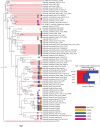Whole genome sequence analysis reveals the broad distribution of the RtxA type 1 secretion system and four novel putative type 1 secretion systems throughout the Legionella genus
- PMID: 31935215
- PMCID: PMC6959600
- DOI: 10.1371/journal.pone.0223033
Whole genome sequence analysis reveals the broad distribution of the RtxA type 1 secretion system and four novel putative type 1 secretion systems throughout the Legionella genus
Abstract
Type 1 secretion systems (T1SSs) are broadly distributed among bacteria and translocate effectors with diverse function across the bacterial cell membrane. Legionella pneumophila, the species most commonly associated with Legionellosis, encodes a T1SS at the lssXYZABD locus which is responsible for the secretion of the virulence factor RtxA. Many investigations have failed to detect lssD, the gene encoding the membrane fusion protein of the RtxA T1SS, in non-pneumophila Legionella, which has led to the assumption that this system is a virulence factor exclusively possessed by L. pneumophila. Here we discovered RtxA and its associated T1SS in a novel Legionella taurinensis strain, leading us to question whether this system may be more widespread than previously thought. Through a bioinformatic analysis of publicly available data, we classified and determined the distribution of four T1SSs including the RtxA T1SS and four novel T1SSs among diverse Legionella spp. The ABC transporter of the novel Legionella T1SS Legionella repeat protein secretion system shares structural similarity to those of diverse T1SS families, including the alkaline protease T1SS in Pseudomonas aeruginosa. The Legionella bacteriocin (1-3) secretion systems T1SSs are novel putative bacteriocin transporting T1SSs as their ABC transporters include C-39 peptidase domains in their N-terminal regions, with LB2SS and LB3SS likely constituting a nitrile hydratase leader peptide transport T1SSs. The LB1SS is more closely related to the colicin V T1SS in Escherichia coli. Of 45 Legionella spp. whole genomes examined, 19 (42%) were determined to possess lssB and lssD homologs. Of these 19, only 7 (37%) are known pathogens. There was no difference in the proportions of disease associated and non-disease associated species that possessed the RtxA T1SS (p = 0.4), contrary to the current consensus regarding the RtxA T1SS. These results draw into question the nature of RtxA and its T1SS as a singular virulence factor. Future studies should investigate mechanistic explanations for the association of RtxA with virulence.
Conflict of interest statement
The authors have declared that no competing interests exist.
Figures




Similar articles
-
Legionella pneumophila cell surface RtxA release by LapD/LapG and its role in virulence.BMC Microbiol. 2024 Jul 19;24(1):266. doi: 10.1186/s12866-024-03395-1. BMC Microbiol. 2024. PMID: 39026145 Free PMC article.
-
Functional type 1 secretion system involved in Legionella pneumophila virulence.J Bacteriol. 2015 Feb;197(3):563-71. doi: 10.1128/JB.02164-14. Epub 2014 Nov 24. J Bacteriol. 2015. PMID: 25422301 Free PMC article.
-
In vivo quantification of the secretion rates of the hemolysin A Type I secretion system.Sci Rep. 2016 Sep 12;6:33275. doi: 10.1038/srep33275. Sci Rep. 2016. PMID: 27616645 Free PMC article.
-
Type 1 Does the Two-Step: Type 1 Secretion Substrates with a Functional Periplasmic Intermediate.J Bacteriol. 2018 Aug 24;200(18):e00168-18. doi: 10.1128/JB.00168-18. Print 2018 Sep 15. J Bacteriol. 2018. PMID: 29866808 Free PMC article. Review.
-
Redefining the bacterial Type I protein secretion system.Adv Microb Physiol. 2023;82:155-204. doi: 10.1016/bs.ampbs.2022.10.003. Epub 2022 Dec 5. Adv Microb Physiol. 2023. PMID: 36948654 Review.
Cited by
-
Legionella pneumophila cell surface RtxA release by LapD/LapG and its role in virulence.BMC Microbiol. 2024 Jul 19;24(1):266. doi: 10.1186/s12866-024-03395-1. BMC Microbiol. 2024. PMID: 39026145 Free PMC article.
-
Genome-based prediction of cross-protective, HLA-DR-presented epitopes as putative vaccine antigens for multiple Bordetella species.Microbiol Spectr. 2024 Jan 11;12(1):e0352723. doi: 10.1128/spectrum.03527-23. Epub 2023 Dec 6. Microbiol Spectr. 2024. PMID: 38054724 Free PMC article.
-
Comprehensive Genomic Analysis Reveals Extensive Diversity of Type I and Type IV Secretion Systems in Klebsiella pneumoniae.Curr Microbiol. 2023 Jul 5;80(8):270. doi: 10.1007/s00284-023-03362-5. Curr Microbiol. 2023. PMID: 37402963
-
Sensing, Signaling, and Secretion: A Review and Analysis of Systems for Regulating Host Interaction in Wolbachia.Genes (Basel). 2020 Jul 16;11(7):813. doi: 10.3390/genes11070813. Genes (Basel). 2020. PMID: 32708808 Free PMC article. Review.
References
-
- Holland IB, Schmitt L, Young J. Type 1 protein secretion in bacteria, the ABC-transporter dependent pathway (review). Mol Membr Biol. 22: 29–39. Available: http://www.ncbi.nlm.nih.gov/pubmed/16092522 10.1080/09687860500042013 - DOI - PubMed
Publication types
MeSH terms
Substances
Supplementary concepts
Associated data
LinkOut - more resources
Full Text Sources
Molecular Biology Databases
Miscellaneous

